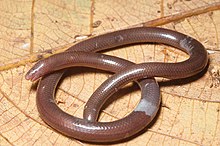| Dibamus | |
|---|---|
 | |
| Dibamus leucurus | |
| Scientific classification | |
| Domain: | Eukaryota |
| Kingdom: | Animalia |
| Phylum: | Chordata |
| Class: | Reptilia |
| Order: | Squamata |
| Family: | Dibamidae |
| Genus: | Dibamus A.M.C. Duméril & Bibron, 1839 [1] [2] |
Dibamus is a genus of legless lizards in the family Dibamidae. [3]